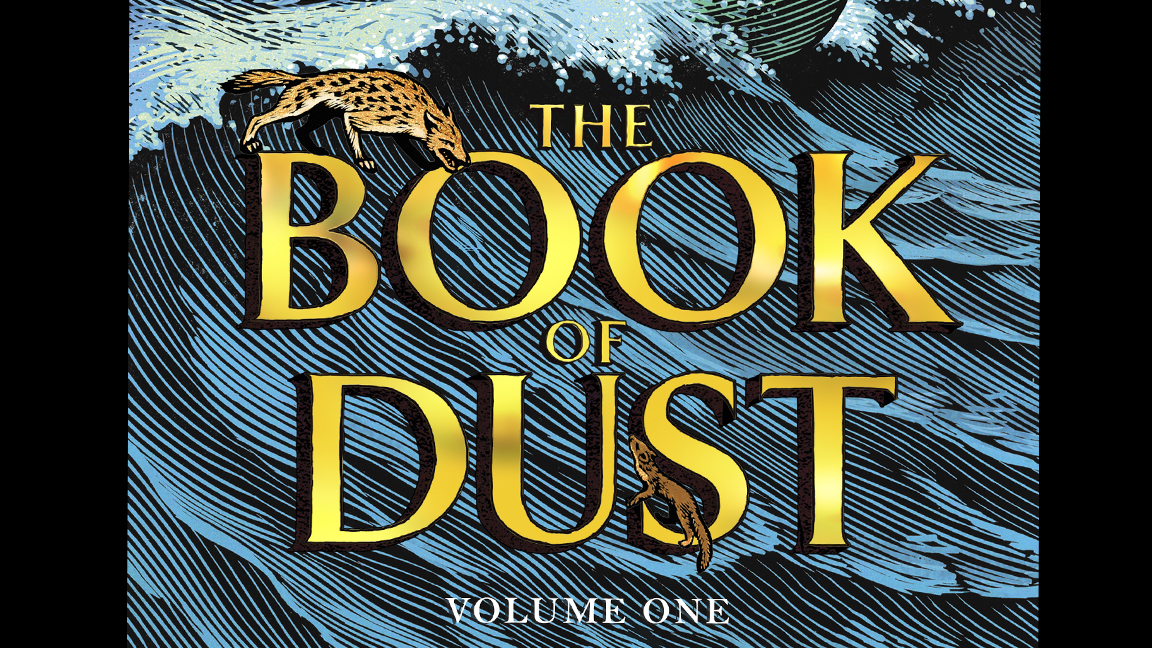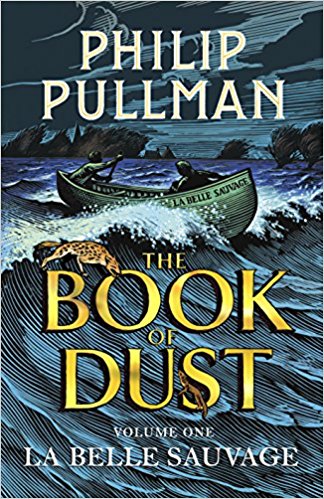Ruby McDonald-Bridge and her daemon share their love of Philip Pullman’s new release La Belle Sauvage: The Book of Dust I, which is taking the world by storm.

The Book of Dust Vol. 1: La Belle Sauvage – my hands, not the small tender ones that first caressed the pages of His Dark Materials many years ago, but the longer, gaunter ones of an adult, have waited all these years to hold the title in physical form, and here it is: heavy and enduring, its name in luminous gold letters, elegant against the gorgeous cover art by artist Chris Wormell. The pristine cream-coloured pages ooze with the rich scent of freshly-printed ink.
La Belle Sauvage is the first volume of three of The Book of Dust, which Pullman has described ‘not as a prequel nor a sequel, but an “equal” to the His Dark Materials books’. His Dark Materials has sold more than 15 million copies and been translated into 40 languages since its publication in 1995. Does the first volume of The Book of Dust live up to its epic predecessor? I am about to find out. I let the magnitude of this moment settle in, and then I begin.
Does the first volume of The Book of Dust live up to its epic predecessor? I am about to find out.
The novel is set ten years prior to The Northern Lights, and is told from the perspective of eleven-year-old boy Malcolm Polstead and his daemon Asta. Malcolm is a compassionate and inquisitive boy with red hair and a stocky, ruddy build – “lion-like” as he was described. He lives on the bank of the Thames, where he splits his time between school, working at The Trout – his home and parent’s inn – and helping out the nuns at the priory just across the river.
All is well for Malcolm – he likes things the way they are. He is an intelligent boy with an interested and “systematic” mind, but he wouldn’t mind if he never went onto higher education. He feels content with the idea of life carrying on just as it is: eavesdropping on the fascinating conversations among the diverse patrons at the inn – scholars and fishermen and travelers from all over; talking with the nuns whilst he assists in their kitchen; traveling up and down the river in his canoe, La Belle Sauvage; coming home to a hot plate of food every evening.
‘The steamy, noisy kitchen was the safest place in the world, it seemed to Malcolm. Safety had never been anything to think about before; it was something you took for granted, like his mother’s endless, effortless, generous food, and the fact that there would always be hot plates ready to serve it on.’
‘Safety had never been anything to think about before; it was something you took for granted, like his mother’s endless, effortless, generous food, and the fact that there would always be hot plates ready to serve it on.’
It isn’t long before his expectations of life continuing to unfold as it always has done are shattered by two critically linked events: the arrival of a baby by the name of Lyra at the priory for her protection, and the discovery of a little wooden acorn, drawing Malcolm into a tumultuous world of politics and danger, thwart with a suffocating atmosphere of suspicion, fear, and change.
It becomes clear from the hubbub that surrounds the event of her arrival that Lyra is an important child. And while the interest seems to come both from those Malcolm trusts and those who wish to do her harm, from the moment he meets her the only thing Malcolm cares for is keeping Lyra safe, whatever that means.
‘Malcolm was enchanted. Everything about her was perfect, and delighted him… He was her servant for life.’
Simultaneously, the tiny acorn he finds contains a secret message, which leads Malcolm to acquainting himself with the erudite scholar Dr Hannah Relf, for whom the note was intended for. Dr Relf is one of the few scholars who study the ways of and, to at least some degree, can read an aleithiometer: a complex instrument that receives questions and will answer with the truth.
Dr Relf is one of the few scholars who study the ways of … an aleithiometer: a complex instrument that receives questions and will answer with the truth.
As it turns out, Dr Relf communicates with a secret service called Oakley Street. They require her to consult the aleithiometer with their queries, which are passed to her secretly on tiny scrolls contained in the hollow of a wooden acorn. Oakley Street was set up with the purpose of protecting democracy and the freedom to pursue knowledge. Their current enemy is the Magisterium: a religious and immensely powerful political force who seek out to enforce and maintain the absolute authority of the Holy Church among all communities. Therefore, the investigation work that Oakley Street pursues is kept underground, including the that Dr Relf is studying for them about the mystery of consciousness.
After their first encounter, Dr Relf and Malcolm establish that they are on the same side: with those who believe thought and speech should be free, and against those who want to stifle speculation and inquiry.
One of the Magisterium’s most disturbing methods for entrenching their totalitarian authority in this book is the League of St. Alexander, a programme introduced to many schools including that which Malcolm attends. The League takes the form of a society for children whose members wear badges and are encouraged to report any sinful behaviour, whatever they deem that to be. One of the first effects of the programme’s introduction is the removal of the headmaster at Malcolm’s school, who tries to forbid students from wearing badges.
‘Mr Willis had defied the League of St Alexander, and now he was being punished. It gave the badge-wearers a giddy sense of power.’
This is an outstanding exemplar of some of the most insidious methods used to entrench fear-based ideologies, the paradigm exposing how powerful a tool terror can be at rapidly changing the dynamics of a community and smother the human love of imagination and inquiry, in a way that is accessible and eye-opening to both children and adults.
This is an outstanding exemplar of some of the most insidious methods used to entrench fear-based ideologies …
‘Other teachers fell into line as well. They taught less vigorously, told fewer stories, lessons became duller and more careful…’
That brings me to one thing I can’t get over – just how accessible Pullman has managed to make this story, and His Dark Materials too, given the complex philosophical backbone that holds it up. His nuance is impeccable: the philosophical and political ideas discussed between characters in often dialogue-heavy scenes could quite easily be hard-going and information-heavy, but Pullman, of course, manages to keep them exhilarating.
While Dr Relf’s side of the story unfolds, Malcolm and Alice, Pullman’s haughty fifteen-year-old heroine, are forced to undertake a dangerous journey in his beloved La Belle Sauvage to protect baby Lyra and deliver her to safety, one that makes you appreciate having dry clean clothes and hot food. It is from here on that the plot begins its ascent to its pinnacle, all parties in the story – good and evil – on the hunt for the missing La Belle Sauvage and its invaluable cargo.
People keep asking me – does it live up to His Dark Materials? Is it better? My answer is always the same: it is equally as good. Just like in His Dark Materials, there are multiple threads running through the story and weaving together to form a strong and exhilarating plot, that is as adventurous and fun as it is intellectually nourishing.
Just like in His Dark Materials, there are multiple threads running through the story and weaving together to form a strong and exhilarating plot …
In this book, Pullman has expanded on his world, a world that is so thorough and complex but in all the right ways: nothing is excessive, everything is there for a purpose and together creates a tapestry that is both easy to comprehend and richly profound, epic, and absorbing. It is a traditional adventure story, a beautiful exploration of childhood and of the human mind, and an exposure to the ways that absolutism can hinder, or even destroy, the freedom to imagine and the pleasure of being alive.

La Belle SauvagE: The Book of DusT I
By Philip Pullman
Published by Penguin and David Fickling Books
RRP: $35.00 (PB) or $48.00 (HB)
Ruby McDonald-Bridge
Ruby McDonald-Bridge is a young writer from Wellington. She has completed a creative writing course in children's fiction at Victoria University, where she also studies philosophy, political science and anthropology. Ruby lives in Lyall Bay and spends her free time reading, writing and swimming in the sea.



